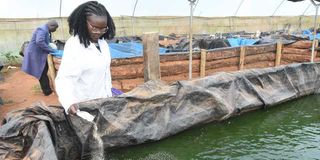Why fish consumption in Rift Valley is rising

Josphat Ariko, a fish hatchery assistant at the University of Eldoret in Uasin Gishu County, and Lydia Muriithi feed fish in surface fish ponds on June 24, 2024.
Consumption of fish is gaining popularity among residents of the North Rift region due to the changing dietary habits and increased adoption of fish farming.
Uasin Gishu County, which a maize and wheat production powerhouse, for example, has launched a fish for health programme. Under the project, fish are auctioned every Friday at the fisheries offices, thus providing a market, and farmers are supplied with high-quality fingerlings.
“Due to the increasing preference for fish over red meat among the residents, there is a growing demand in the market, making commercial fish farming a thriving industry in the region,” states the Uasin Gishu fisheries department in its monthly update report.
Investment in fish farming has been boosted thanks to a partnership between devolved units in the North Rift region and the University of Eldoret aimed at promoting aquaculture as an alternative source of income.
An estimated 3,600 farmers in the region have ventured into farm fishing, which generated an estimated Sh240 million in the last financial year.

Josphat Ariko, a fish hatchery assistant at the University of Eldoret in Uasin Gishu County watches as Lydia Muriithi feeds fish in a fish pond on June 24 at the university farm.
According to Dr Simon Agembe, the Head of Department of Fisheries and Aquatic Science at the University of Eldoret, approximately 2,500 to 3,000 tilapia fingerlings are produced daily at the institution’s hatchery to meet the increasing demand for the popular fish variety.
“The construction of the hatchery was funded by the Uasin Gishu County government. The initial running of the hatchery was funded by both the county government and the university,” explained Dr Agembe.
The hatchery sells tilapia fingerlings at Sh5 a piece, catfish at Sh10 each and ornamental fish at Sh100 per inch.
“Our target is to produce 50,000 fingerlings weekly and about 1.2 million monthly to meet the increasing demand for table fish in western Kenya driven by fast-changing eating habits,” he disclosed.
Supplementing funding
The university’s vice-chancellor, Prof Thomas Kimeli Cheruiyot, said that the institution generates Sh20 annually from the project, supplementing funding from the National Treasury.
“There is high demand for fingerlings from fish farmers in the North Rift and beyond while ornamental fish is sold on retail and wholesale terms,” explained the VC.
A medium-size tilapia fish goes for between Sh300 and Sh500, which the farmers said was more profitable compared to maize or wheat.

Fish in a surface pond at the University of Eldoret’s fish hatchery in Uasin Gishu County on June 24, 2024.
“Fish farming is much more profitable as compared to cereal production. One can rear 1,500 in an eighth of an acre which can be sold at a minimum of Sh200 a piece after six months, translating to Sh300,000. Planting maize would yield four bags, which when sold at the market price of Sh4,000 per bag would generate Sh16,000,” explained Wilson Too from Marura, who has invested in fish farming.
There is also high demand for fish by learning institutions in the region for biology practical lessons and as a source of protein for learners.
Easily sourced
“Initially, schools in the region used to get fish for use as specimens in laboratories from as far as Kisumu, but the fish can now be easily sourced from fish ponds in the region. There is even enough for the students to eat,” said Martin Kosgei, a teacher at a secondary school in Nandi County.
The West Pokot County government has teamed up with the Kerio Valley Development Authority to stock fingerlings in the Turkwel dam and support commercial fishing activities as an alternative source of income for more than 300,000 people in the area.
“Fishing is gaining popularity among the locals due to change in eating habits, transforming it into a lucrative investment,” said Mark Lomokiriong’, one of the fish mongers.
According to KVDA Managing Director Samuel Naporos, the locals have been empowered with modern fish farming techniques and gear.
“The facility supports more than 300 fishmongers and other traders at the dam, improving livelihoods,” he said.





